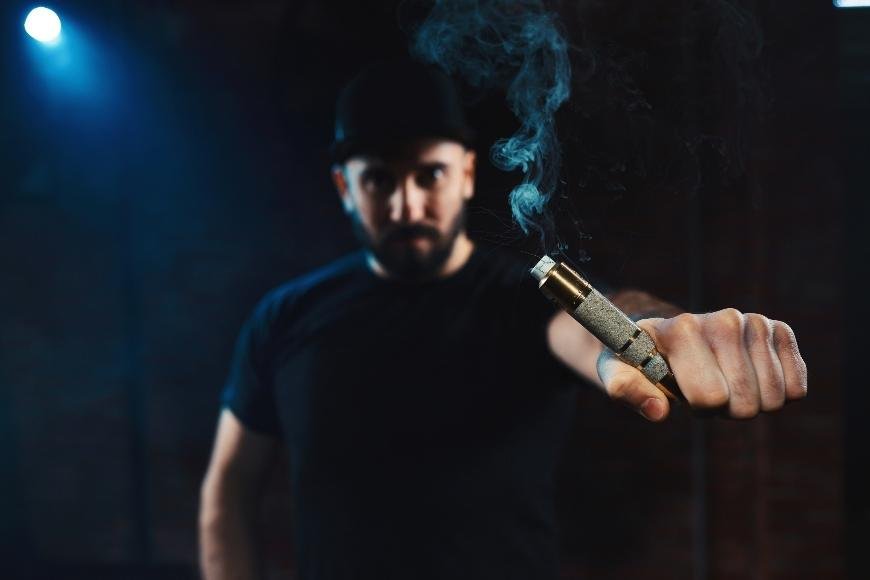How to Use Salvia Divinorum
Discover the best ways to use Salvia Divinorum, including smoking and oral administration. Learn about differences in effects between methods.

Welcome to our blog post on Salvia Divinorum. If you're interested in learning about the active ingredient of this plant and its drug profile, then you've come to the right place. In this post, we will explore the history and traditional use of Salvia Divinorum, its current legal status, potential risks associated with consumption as well as the science behind Salvinorin A - the active ingredient responsible for its psychoactive effects.
We will also delve into the science behind Salvinorin A - the active ingredient responsible for the psychoactive effects of Salvia Divinorum. Our objective is to furnish you with an exhaustive comprehension of its mechanism in the brain and what sets it apart from other hallucinogens.
Furthermore, we will explore some common misconceptions surrounding Salvia Divinorum and clarify them based on scientific evidence. By doing so, we hope that you can make informed decisions regarding your own safety when consuming or considering consuming this plant.
In conclusion, this blog post offers a comprehensive examination of Salvia Divinorum's active ingredients and drug profile to help you make informed decisions regarding its consumption.
Table of Contents:
- What is Salvia Divinorum?
- How to Prepare Salvia Divinorum for Use
- Smoking Salvia Divinorum
- Vaporizing Salvia Divinorum
- Sublingual Administration of Salvia Divinorum
- Oral Administration of Salvia Divinorum
- Differences in Effects Between Methods of Use
- FAQs in Relation to How to Use Saliva Divinorum
- Conclusion
What is Salvia Divinorum?
Salvia divinorum is an uncommon plant species native to Mexico and Central America, traditionally utilized by the Mazatec people in spiritual ceremonies and healing practices. It has been used for centuries by the Mazatec people as an aid to spiritual visions and healing rituals. The active ingredient in Salvia Divinorum is salvinorin A, a potent kappa opioid receptor agonist that produces powerful psychedelic effects when consumed.
Smoking Salvia Divinorum is the most common way of consuming it, though vaporizing or sublingual administration are also possible. When smoked, salvinorin A quickly enters the bloodstream through the lungs and begins to take effect within seconds. Effects typically last between 10-30 minutes before fading away completely without any lingering side effects or hangover symptoms.
Vaporizing Salvia Divinorum requires special equipment such as a vaporizer pen or desktop vaporizer device that can heat up dried herb material at lower temperatures than smoking does (around 250°F). This method of consumption allows for more precise dosing and less smoke inhalation than smoking it directly from a pipe or bong would allow for.
Sublingual absorption of Salvia Divinorum, achieved by placing crushed leaves under the tongue to dissolve into saliva over time, offers a slightly slower onset but longer-lasting effects compared to other consumption methods. This is due to its rapid rate of absorption through the mucous membranes located on either side of the tongue which are much more effective at absorbing salvinorin A than stomach acid breaking down ingested material forms would be if swallowed orally instead.
Salvia Divinorum is an exceptional plant that has been employed for ages by shamans and healers to attain spiritual insight. By learning how to prepare it properly, you can experience the same effects as these ancient practitioners. Next, we will explore how to safely prepare Salvia Divinorum for use.
How to Prepare Salvia Divinorum for Use
Native to the Oaxaca region of Mexico, Salvia divinorum has been used by the Mazatec Indians for centuries in religious and healing ceremonies. It has been used for centuries by the Mazatec Indians in religious and healing ceremonies. Salvinorin A, a powerful psychedelic found in Salvia divinorum native to the Oaxaca region of Mexico and used by the Mazatec Indians for centuries in religious and healing ceremonies, must be handled with caution due to its potency. Preparation of this plant for use requires careful attention to detail and knowledge of its effects.
The first step in preparing Salvia Divinorum for use is harvesting it correctly. The leaves should be harvested when they are still green and pliable; if they are too dry or browning, then they will not produce an effective effect when consumed. After harvesting, the leaves should be air-dried over a period of approximately two weeks to attain maximum potency before being stored away from light and moisture in impermeable containers.
Grind the dried leaves into a fine powder using either a mortar & pestle or electric grinder for accurate dosing. This makes it easier to measure out exact doses later on without having to count individual leaf pieces each time you want to take some Salvia Divinorum. Once ground up, store your powdered Salvia Divinorum in an airtight container away from heat and light sources so that it stays potent over time.
Finally, you can prepare your dose by measuring out an amount based on how much experience you have with Salvia Divinorum's effects (see below). If you are just starting out with this substance, start with small amounts like 1/4th teaspoon per dose and work your way up gradually over time as needed; always remember that more is not necessarily better. Once measured out accurately according to personal preference or experience level, there are several different ways that one can consume their prepared dose: smoking it via pipe, bong or joint; vaporizing it using a vaporizer device; sublingually (under the tongue) via tincture form; or orally via tea infusion method (the latter two methods may require further preparation steps).
Preparing Salvia Divinorum for use requires great caution and should be done with meticulous attention to detail. Moving on, we will discuss how to smoke this powerful substance safely and effectively.
Smoking Salvia Divinorum
Smoking Salvia Divinorum is the most common method of ingestion for this powerful psychedelic plant. Indigenous peoples in Mexico have been utilizing this potent psychedelic plant for ages, and it has recently gained traction among recreational drug users. Smoking salvinorin A, the active ingredient in Salvia Divinorum, is the most common method of ingestion for this powerful psychedelic plant and can be done using dried leaves or extracts.
When using salvia divinorum, it is essential to be cautious as the effects can be intense; this includes visual and auditory hallucinations that could become hazardous if not handled with care. For a safe experience, begin with an amount of 0.5g and build up until the desired effects are noticed. It’s also important to have someone present who can help guide you through the experience if needed and make sure that your environment is comfortable and free of distractions before beginning your journey with salvia divinorum.
Pack the material tightly in a pipe or bong to ensure an even heat distribution and maximum potency, while avoiding any potential health risks from inhaling burnt plant matter directly into the lungs. Doing so will prevent hot spots on some parts of the material which could lead to uneven heating resulting in an unpleasant taste due to burning rather than vaporizing of materials being consumed during inhalation processes.
Smoking Salvia Divinorum is a popular way to experience its effects, but vaporizing it can provide an even more intense and unique experience. Vaporizing Salvia Divinorum requires different techniques and equipment than smoking, so let's take a look at how this method works.
Vaporizing Salvia Divinorum

Vaporizing salvia divinorum is a common technique for taking in the active compound, salvinorin A, from this herb. Vaporizing involves heating up dried leaves or extracts of the plant until they reach their boiling point and releasing the vapor into the air. This method allows users to inhale only the active ingredients without any additional toxins from combustion that can be present when smoking it.
When vaporizing salvia divinorum, it’s important to use caution and follow safety guidelines for proper ventilation and protection from heat sources. It’s also essential to use high-quality equipment designed specifically for vaping herbs like this one, as low-grade products may contain hazardous materials such as lead or other metals that could potentially contaminate your product. When using an electric device, make sure it has adjustable temperature settings so you can find just the right level for maximum effect while avoiding burning your material too much.
It's recommended to start with a lower temperature setting at first before gradually increasing until desired effects are achieved. The amount needed will vary depending on individual tolerance levels but typically ranges between 1–3 grams per session (although more experienced users may require higher doses). For optimal results, it is suggested not to go beyond 4 grams for each session; amounts above this can cause disagreeable effects such as feeling sick or lightheaded.
The duration of effects depends on how much was consumed; however, most people report feeling its effects within minutes after inhalation and lasting anywhere from 15-30 minutes afterwards (longer if taken orally). Salvia divinorum, favored by recreational drug users for its ability to induce intense visual hallucinations, feelings of euphoria and altered states of consciousness, has become increasingly popular.
Vaporizing Salvia Divinorum is a popular method of consuming the plant, as it can provide users with an intense and powerful experience. Sublingual administration may be another option for those seeking to explore this substance in greater depth.
Sublingual Administration of Salvia Divinorum
Sublingual administration of salvia divinorum is a method for consuming the active ingredient, salvinorin A. This process involves placing the dried leaves or extract of the plant under your tongue and allowing it to dissolve. The effects of sublingual administration can be experienced quickly, with the duration lasting up to half an hour depending on amount taken.
When considering sublingual administration of salvia divinorum, safety should always be taken into account. Due to its hallucinogenic properties, this drug should only be used in a controlled environment with people you trust and who understand what they are doing.
The dosage amount when using sublingual administration varies greatly depending on individual tolerance levels and desired effects; however, most users start off with 1-2mg per dose before increasing if necessary over time. It’s important not to exceed 5mg per dose due to potential adverse reactions such as nausea and dizziness that may occur at higher dosages. Additionally, there have been reports of disorientation which can lead to dangerous situations so caution must always be exercised when taking this substance orally or sublingually regardless of dosage amount used .
Ingesting Salvia Divinorum sublingually can be a safe and efficient approach, however it is essential to investigate beforehand. Moving on from sublingual administration, let's explore oral administration of Salvia Divinorum.
Oral Administration of Salvia Divinorum
Ingesting salvia divinorum orally is a common approach for consuming its active component, salvinorin A. Salvinorin A is a powerful psychoactive compound found in the plant and has hallucinogenic effects when consumed. Oral administration involves either chewing on fresh leaves or making an extract from dried leaves to be taken orally as drops or capsules.
When utilizing new foliage, it is essential to masticate them thoroughly prior to gulping down in order to enhance the body's uptake of the potent elements. It may take up to 30 minutes for full effects to be felt after oral ingestion and can last anywhere from 1-2 hours depending on dosage and individual metabolism.
Making an extract from dried leaves is also possible but requires specialized equipment such as a rotary evaporator or distillation setup which can be expensive and time consuming. Extracts should only be made by experienced individuals with knowledge of proper safety procedures due to potential risks associated with working with solvents such as acetone, ethanol, etc When taking extracts orally, it’s important not to exceed recommended dosages as salvinorin A can have strong psychoactive effects at higher doses that could lead to adverse reactions if not prepared correctly beforehand.
It is important to note that while oral consumption does provide some benefits over other methods, such as increased bioavailability, it also carries certain risks such as nausea and vomiting due to irritation caused by high concentrations of salvinorin A in the stomach lining. This could potentially cause damage if ingested too frequently or in large amounts without proper preparation beforehand. Therefore, caution should always be exercised when considering any form of consumption involving salvia divinorum regardless of method used.
The oral administration of Salvia Divinorum is a unique way to experience the effects of this powerful plant, and it's important to understand how different methods can affect your experience. Examining the discrepancies between various modes of Salvia Divinorum ingestion can aid in making an informed decision about which technique is most appropriate for one's needs.
Differences in Effects Between Methods of Use

Inhaling the smoke deeply into the lungs facilitates quick absorption of Salvia Divinorum's effects, resulting in a potentially intense experience lasting up to 15 minutes or more. Inhaling the smoke can produce an intense, potentially long-lasting journey of sensations. Some users report feeling a sense of euphoria, increased visual acuity, altered perception of time and space, vivid hallucinations and profound spiritual experiences.
Vaporizing Salvia Divinorum also produces an intense experience with rapid onset effects but at a slightly lower intensity than smoking. Vaporizing involves heating salvia leaves in an electronic device until they release their active compounds as vapor without burning them like when smoking. This reduces some of the harshness associated with smoking while still providing strong effects that may last up to 10 minutes or longer depending on dosage and individual physiology. Commonly reported effects include feelings of relaxation and well-being along with heightened awareness and enhanced visuals including trails from moving objects such as lights or flames.
Sublingual administration entails the placement of salvinorin A, the primary psychoactive constituent found in salvia divinorum, under one's tongue for absorption into their bloodstream through mucous membranes present. This method results in a powerful yet brief experience which usually reaches its apex within five minutes after ingestion before gradually dissipating over the following half-hour or so; leaving an individual feeling relaxed but with clear faculties compared to other methods which tend to leave them more disoriented due to their lengthier duration times coupled with greater intensity levels experienced during peak periods.
FAQs in Relation to How to Use Saliva Divinorum
What is salvia used to treat?
Salvia, a psychoactive plant with potential medicinal properties, is employed to treat various ailments including depression, nervousness and persistent pain. It has been studied for its potential to help people with addiction problems and even post-traumatic stress disorder (PTSD). Salvia's effects are short-lived but can be intense; it produces feelings of relaxation, altered perception of time and space, visual distortions or hallucinations. Salvia should only be consumed under the supervision of a knowledgeable individual, as improper use may result in negative reactions such as an accelerated heartbeat or disorientation.
What is the drug composition of salvia?
Salvia is a psychoactive plant containing several active compounds, the most notable of which are salvinorin A and divinorum. Salvinorin A is an opioid-like compound that produces hallucinatory effects when ingested or inhaled. Divinorum contains a mix of other alkaloids including dihydroergocristine, dihydroergocryptine, and dihydromethysticum which have milder psychedelic properties than salvinorin A. All these components together make up the drug composition of salvia.
Is Sage and salvia divinorum the same thing?
No, sage and salvia divinorum are not the same thing. Sage, a culinary herb from the mint family with an intense smell, is distinct from Salvia Divinorum, which belongs to the sage family and has been used by native Mexicans for religious purposes due to its psychoactive properties. Sage belongs to the mint family and has a strong aroma, whereas Salvia Divinorum belongs to the sage family and contains active compounds known as Salvinorins which can produce psychoactive effects when ingested or smoked.
Is salvia officinalis a hallucinogen?
No, Salvia officinalis is not a drug that induces hallucinations. It is an herb that has been used for centuries in traditional medicine and cooking. Although it does contain certain psychoactive substances, these are not powerful enough to induce hallucinations or any other trippy experiences when taken alone. The most common side effect reported from consuming salvia officinalis is mild sedation or relaxation.
Conclusion
When handled with care, salvia divinorum can provide a powerful experience that may open up new perspectives or simply bring about feelings of serenity. With the right preparation and method of use, salvia can provide an intense experience that may offer insights into your inner self or simply bring about feelings of peace and relaxation. No matter what you choose to do when using salvia divinorum, always remember to stay safe and enjoy the journey.






































































































































